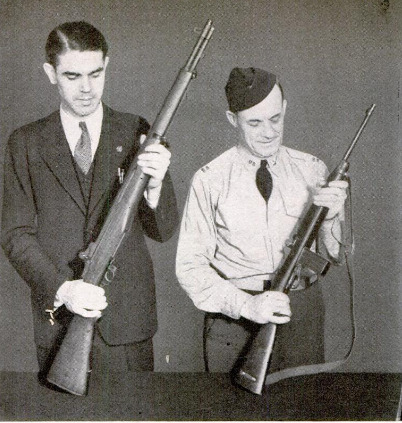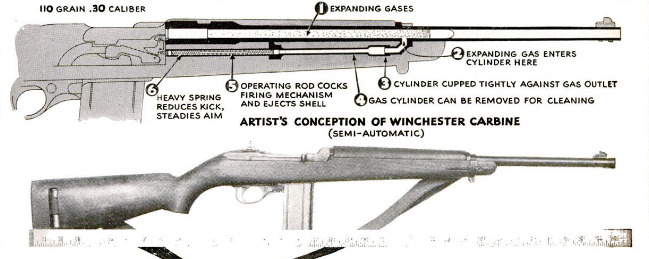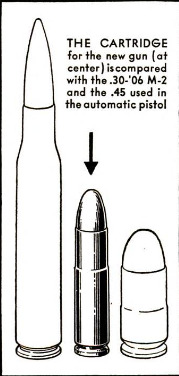Lightweight carbine increases army's fire power
Item
-
Title (Dublin Core)
-
Lightweight carbine increases army's fire power
-
Article Title and/or Image Caption (Dublin Core)
-
Title: Lightweight carbine increases army's fire power
-
extracted text (Extract Text)
-
UNCLE SAM is arming many of his sol-
diers with a new gun. Officially tagged
U.S. Carbine Caliber .30 M-1, it is at
present in production and will no doubt be
with troops by the time you read this. The
new light gun will replace about 80 percent
of the .45 caliber automatic (self-loading)
pistols now being used in the service.
Present-day so-called “blitz” warfare is
nothing more than a modernized version of
cavalry tactics worked out many years ago
—the idea being to get at an ememy’s weak
point with a superior force.
In this type of warfare, utilizing modern,
fast equipment such as tanks and planes,
the combat zone may be fifty, 100, or even
200 miles deep as compared with the several
hundred yard zone of trench warfare as we
saw it in World War I. Consequently, ar-
tillerymen, motorcyclists, ammunition car-
riers, and other soldiers whose personal
arms are of secondary importance must be
equipped with means of entering into dead-
ly struggle at any time.
Now, the .45 automatic pistol, besides
being the most difficult of all weapons to
master, is just not enough gun for this pur-
pose. So the War Department decided to
adopt a weapon light enough to be carried
by such troops so they would not be un-
necessarily burdened in the execution of
their normal duties—and yet be able to de-
velop effective fire power at several hundred
yards.
Specifications were drawn up, calling for
a five-pound semi-automatic rifle chambered
for a new light but powerful .30 or .32. cal-
iber cartridge, equipped
with a 20-round magazine
and light carrying sling; |
the gun to be as simple
and reliable as possible,
easily operated by hand if
necessary, and as accurate |
as the regular service rifle
up to at least 300 yards.
When the initial test
board convened, several
pilot models were sub- |
mitted by various com-
panies and individual de- |
signers. As the testing for |
accuracy, sustained firing,
and exposure progressed,
one gun stood out above |
all the rest. It took more |
abuse, held up longer:
under sustained firing, and
had fewer broken parts. |
This gun, which was sub- |
mitted by the Winchester
Repeating Arms Company,
is something entirely new
and different as far as the
U.S. Army is concerned.
It is 7 1/2; inches shorter and
weighs only about half as |
much as the Army's:
full-power Garand
semiautomatic rifle.
It tips the scale at
around 4 1/2 pounds. |
The magazine holds 15
rounds of a new car-
tridge which has a .30
caliber, 110-grain bul-.
let seated in a straight
rimless case. It is
loaded with a smoke-
less-powder charge to’
develop about 40,000 pounds pressure per
square inch which pushes the bullet at 2,000
feet a second at the muzzle.
The extracting, loading, and locking mech-
anism is gas-and-spring operated. Gas from
the fired cartridge opens the breech mech-
anism, cocks the firing pin, and tosses out
the empty case. Immediately a recoil spring
closes the action, which automatically cham-
bers a live cartridge.
In the design of the new lightweight weap-
on. the Winchester engineers took advantage
of the fact that gas drawn
off close to the chamber
before cooling can take
place prevents carboniza-
tion of a weapon's piston
and gas port. This feature
eliminates considerable
trouble in the field and the
necessity of frequent car-
bon scraping.
The new-type carrying
sling permits the gun to be
carried slantwise across
the back, leaving both
hands free.
Army experts estimate
that adoption of the new
weapon will increase of-
fensive fire power a full
33 percent. This is based
on the theory that volume
is more effective than ac-
curacy on the battlefield.
But, certainly, all shots
fired from these little rifles
will be several times more
accurate than those dis-
charged from the .45 cali-
ber pistol formerly used
for the same purposes.
-
Contributor (Dublin Core)
-
Pete Kuhlhoff (article writer)
-
Language (Dublin Core)
-
Eng
-
Date Issued (Dublin Core)
-
1942-06
-
pages (Bibliographic Ontology)
-
79-80
-
Rights (Dublin Core)
-
Public domain
-
Archived by (Dublin Core)
-
Sami Akbiyik
 Popular Science Monthly, v. 140, n. 6, 1942
Popular Science Monthly, v. 140, n. 6, 1942








